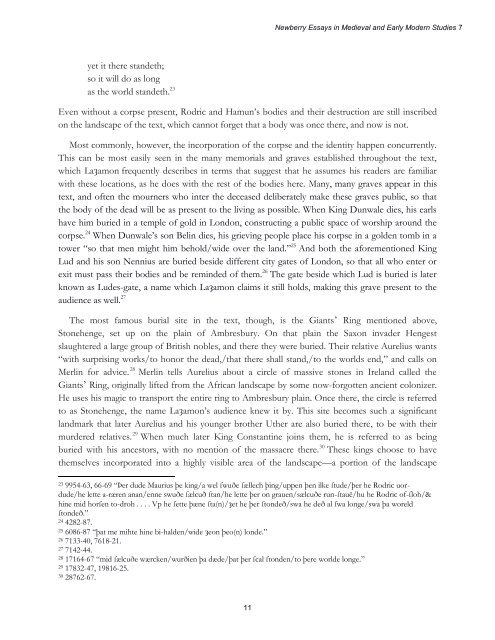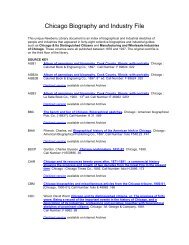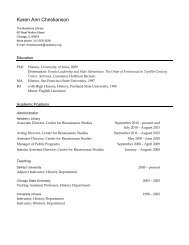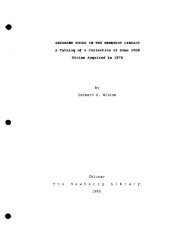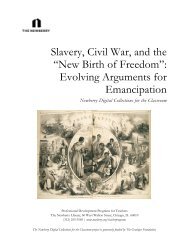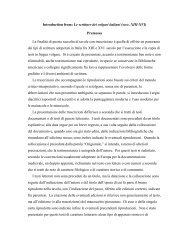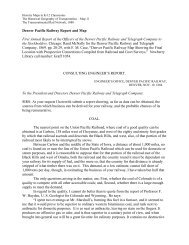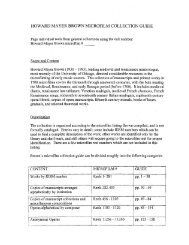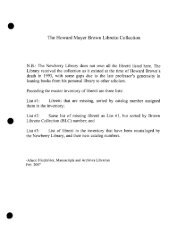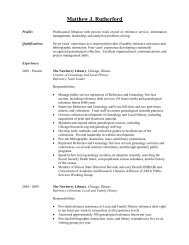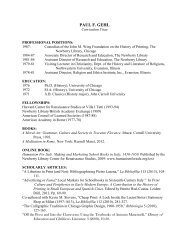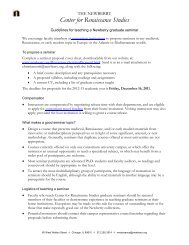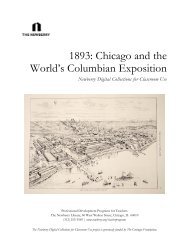Newberry Essays in Medieval and Early Modern ... - Newberry Library
Newberry Essays in Medieval and Early Modern ... - Newberry Library
Newberry Essays in Medieval and Early Modern ... - Newberry Library
You also want an ePaper? Increase the reach of your titles
YUMPU automatically turns print PDFs into web optimized ePapers that Google loves.
<strong>Newberry</strong> <strong>Essays</strong> <strong>in</strong> <strong>Medieval</strong> <strong>and</strong> <strong>Early</strong> <strong>Modern</strong> Studies 7yet it there st<strong>and</strong>eth;so it will do as longas the world st<strong>and</strong>eth. 23Even without a corpse present, Rodric <strong>and</strong> Hamun’s bodies <strong>and</strong> their destruction are still <strong>in</strong>scribedon the l<strong>and</strong>scape of the text, which cannot forget that a body was once there, <strong>and</strong> now is not.Most commonly, however, the <strong>in</strong>corporation of the corpse <strong>and</strong> the identity happen concurrently.This can be most easily seen <strong>in</strong> the many memorials <strong>and</strong> graves established throughout the text,which Laȝamon frequently describes <strong>in</strong> terms that suggest that he assumes his readers are familiarwith these locations, as he does with the rest of the bodies here. Many, many graves appear <strong>in</strong> thistext, <strong>and</strong> often the mourners who <strong>in</strong>ter the deceased deliberately make these graves public, so thatthe body of the dead will be as present to the liv<strong>in</strong>g as possible. When K<strong>in</strong>g Dunwale dies, his earlshave him buried <strong>in</strong> a temple of gold <strong>in</strong> London, construct<strong>in</strong>g a public space of worship around thecorpse. 24 When Dunwale’s son Bel<strong>in</strong> dies, his griev<strong>in</strong>g people place his corpse <strong>in</strong> a golden tomb <strong>in</strong> atower “so that men might him behold/wide over the l<strong>and</strong>.” 25 And both the aforementioned K<strong>in</strong>gLud <strong>and</strong> his son Nennius are buried beside different city gates of London, so that all who enter orexit must pass their bodies <strong>and</strong> be rem<strong>in</strong>ded of them. 26 The gate beside which Lud is buried is laterknown as Ludes-gate, a name which Laȝamon claims it still holds, mak<strong>in</strong>g this grave present to theaudience as well. 27The most famous burial site <strong>in</strong> the text, though, is the Giantsʼ R<strong>in</strong>g mentioned above,Stonehenge, set up on the pla<strong>in</strong> of Ambresbury. On that pla<strong>in</strong> the Saxon <strong>in</strong>vader Hengestslaughtered a large group of British nobles, <strong>and</strong> there they were buried. Their relative Aurelius wants“with surpris<strong>in</strong>g works/to honor the dead,/that there shall st<strong>and</strong>,/to the worlds end,” <strong>and</strong> calls onMerl<strong>in</strong> for advice. 28 Merl<strong>in</strong> tells Aurelius about a circle of massive stones <strong>in</strong> Irel<strong>and</strong> called theGiantsʼ R<strong>in</strong>g, orig<strong>in</strong>ally lifted from the African l<strong>and</strong>scape by some now-forgotten ancient colonizer.He uses his magic to transport the entire r<strong>in</strong>g to Ambresbury pla<strong>in</strong>. Once there, the circle is referredto as Stonehenge, the name Laȝamon’s audience knew it by. This site becomes such a significantl<strong>and</strong>mark that later Aurelius <strong>and</strong> his younger brother Uther are also buried there, to be with theirmurdered relatives. 29 When much later K<strong>in</strong>g Constant<strong>in</strong>e jo<strong>in</strong>s them, he is referred to as be<strong>in</strong>gburied with his ancestors, with no mention of the massacre there. 30 These k<strong>in</strong>gs choose to havethemselves <strong>in</strong>corporated <strong>in</strong>to a highly visible area of the l<strong>and</strong>scape—a portion of the l<strong>and</strong>scape23 9954-63, 66-69 “Þer dude Maurius þe k<strong>in</strong>g/a wel ſwuðe ſællech þ<strong>in</strong>g/uppen þen ilke ſtude/þer he Rodric uordude/helette a-ræren anan/enne swuðe ſælcuð ſtan/he lette þer on grauen/sælcuðe run-ſtauē/hu he Rodric of-ſloh/&h<strong>in</strong>e mid horſen to-droh . . . . Vp he ſette þæne ſta(n)/ȝet he þer ſtondeð/swa he deð al ſwa longe/swa þa woreldſtondeð.”24 4282-87.25 6086-87 “þat me mihte h<strong>in</strong>e bi-halden/wide ȝeon þeo(n) londe.”26 7133-40, 7618-21.27 7142-44.28 17164-67 “mid ſælcuðe wærcken/wurðien þa dæde/þat þer ſcal ſtonden/to þere worlde longe.”29 17832-47, 19816-25.30 28762-67.11


